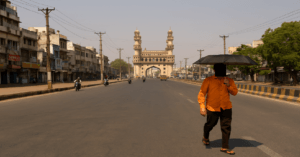Hyderabad’s Scorching Summers: 3 Deadly Heat Challenges & Solutions
Hyderabad’s summers are becoming increasingly harsh due to Urban Heat Islands (UHI) and Wet Bulb Temperatures, making the city feel hotter despite lower recorded temperatures compared to surrounding districts. High humidity prevents sweating, reducing the body’s ability to cool itself, while hot winds (loo) add to the discomfort, often leading to heat exhaustion and strokes. The Urban Heat Island effect worsens the problem, as concrete structures, narrow streets, and deforestation trap heat, keeping nighttime temperatures high.
To combat extreme heat, authorities advise avoiding outdoor activities between 12 PM and 3 PM, staying hydrated, and recognizing heatstroke symptoms like dizziness, confusion, and high body temperature. Solutions include increasing tree cover, using heat-reflective roofing, improving urban ventilation, and conserving water resources to create a cooler environment. With rising global temperatures, Hyderabad must adopt sustainable solutions to reduce heat impact. Until then, residents should take necessary precautions to stay safe during extreme summer conditions.

Hyderabad’s Scorching Summers: 3 Deadly Heat Challenges & Solutions
Hyderabad’s summers have become increasingly brutal, leaving residents feeling trapped in an oven. While the city’s daytime temperatures are often slightly lower than nearby rural areas, the heat feels more intense due to a mix of urban design flaws and weather patterns. Let’s break down why this happens and how locals can protect themselves.
The Double Trouble: Humidity and Hot Winds
Two key factors make Hyderabad’s heat unbearable: stifling humidity and scorching winds. Humidity—the moisture in the air—plays a sneaky role. When humidity is high, sweat doesn’t evaporate easily, robbing the body of its natural cooling mechanism. This creates a “wet bulb temperature” effect, a critical measure combining heat and humidity. If the wet bulb temperature hits 35°C, the human body can no longer cool down, leading to heatstroke, organ failure, or even death. Though Hyderabad hasn’t reached this threshold yet, summer humidity combined with 40°C temperatures makes outdoor work or activities risky.
Adding to this are the loo—dry, blazing winds blowing across the city. These winds, common in arid regions, feel like gusts from a desert, dehydrating the skin and amplifying discomfort. Even at 40°C, the mix of humidity and loo can make it feel hotter than the thermometer suggests.
Concrete Jungles Trap Heat: The Urban Heat Island Effect
Hyderabad’s rapid growth has turned it into an “urban heat island.” Concrete buildings, narrow lanes, and paved surfaces absorb heat during the day and release it slowly at night, keeping temperatures high even after sunset. Rural areas, with more open spaces, trees, and soil, cool down faster. In Hyderabad, however, heat gets trapped between tall buildings that block breezes, while roads and rooftops act like giant heaters. Less greenery means fewer trees to provide shade or release moisture into the air.
Ironically, nearby districts like Medak or Rangareddy might record higher daytime temperatures, but Hyderabad feels hotter because of this heat-trapping effect. Nights offer little relief, as urban materials radiate stored heat, disrupting sleep and increasing health risks.
Health Risks: Recognizing Heatstroke
Prolonged exposure to extreme heat can be deadly. Hyderabad’s health department warns residents to stay indoors between 12 PM and 3 PM, when the sun is fiercest. Heatstroke symptoms include:
- Confusion or dizziness
- Body temperature soaring to 40°C (104°F) or higher
- Rapid heartbeat, shallow breathing, or nausea
- Loss of coordination (stumbling, inability to walk straight)
If someone shows these signs, move them to shade, cool their body with water, and seek medical help immediately. Delaying treatment can lead to coma or death.
Staying Safe: Simple Steps Matter
To survive the summer:
- Hydrate constantly: Drink water even if you’re not thirsty. Avoid alcohol or caffeine, which dehydrate.
- Dress smart: Wear loose, light-colored cotton clothes to reflect heat.
- Avoid peak sun: Postpone outdoor tasks to early mornings or evenings.
- Cool your home: Use curtains, fans, or coolers. Wet cloths on windows can help lower indoor temps.
Fixing the Heat Trap: Long-Term Solutions
Hyderabad needs urgent action to combat rising temperatures. Here’s what can help:
- Plant more trees: Green cover along roads and parks provides shade and releases moisture, cooling the air.
- Rethink urban design: Wider streets, open spaces, and buildings that allow airflow can reduce heat retention.
- Cool roofs: Painting roofs white or using reflective materials can slash indoor temperatures.
- Save water: Lakes and ponds cool neighborhoods. Reviving Hyderabad’s dying water bodies could help.
The Bigger Picture
Climate change is making summers hotter globally, but cities like Hyderabad can adapt. While individuals must stay cautious, authorities need to prioritize sustainable planning. For now, staying informed and taking simple precautions can make Hyderabad’s summers survivable—and hopefully, future-proof the city against escalating heat threats.
Stay cool, stay safe, and remember: the sun won’t relent, but smart choices can keep you protected.
You must be logged in to post a comment.